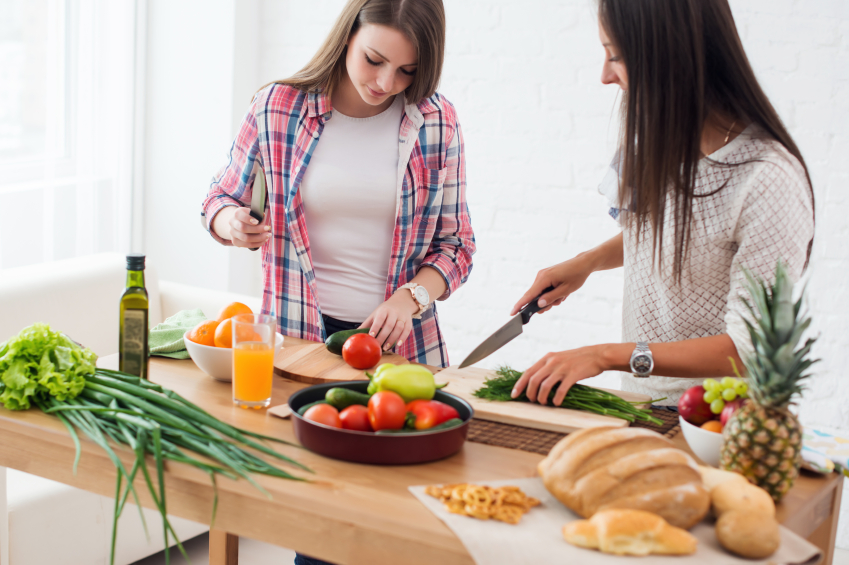
It would be a fair to say that alternative diets are one the rise. Dietary restrictions, food allergies, and food intolerances have definitely become more common place in today’s society. For example, when I was growing up my parents had to have wheat and egg-free bread/crackers/cookies etc. shipped to our small town all the way from Toronto. Today my small town grocery store has it’s own health food section! Along with food allergy conscious diets, another diet that has increased in popularity and awareness is the vegan diet. Following a vegan diet does not include any food products that come from animal origin (i.e. meat, milk, eggs, honey, etc.) and in many cases this philosophy will extend to avoiding other items that may contain animal products (i.e. clothing, cosmetics, and cleaning products). When it comes to vegan baking and cooking at home, I find it fits in nicely with cooking and baking with food allergies, the main reason being it’s all about SUBSTITUTIONS!
When it comes to replacing milk in cooking and baking there are multiple non-dairy milks available that can easily be found in various grocery and health food stores. Soy milk is one option for those who do not have a soy allergy. Other options include almond milk, coconut milk, rice milk, and hemp milk. It should be stressed, however, that these milks all have different tastes and consistencies and can behave differently in recipes. For example, soy milk has a particular tendency to curdle and actually works best as a buttermilk substitute by adding vinegar or lemon juice and letting it sit for approximately five minutes. Coconut milk is a thicker milk and can be a great option for adding body and flavour to recipes such as frosting or icings when baking! Rice milk and almond milk are thinner milk alternatives and can be great for adding moisture to recipes. All it takes is a little extra research and thought into what you are cooking and baking and what purpose milk is serving in your recipe.
Eggs serve many different purposes in recipes and therefore many different ingredients can be used as a substitution based on what the eggs are being used for in a recipe. Applesauce or mashed bananas are options that can add body and moisture to a recipe. Ground flax seed and water can be combined to form a gelatinous texture and work to add a chewier, dense texture to baked goods. A commercial egg replacer can also be purchased which helps when you bake by binding ingredients and helping them rise. My friend once shared an article with me that stated using the liquid found in cans of chickpeas (I kid you not) served as an alternative to eggs when making meringue topping— please note I have not tried this food experiment so I can’t actually testify that it works! What this does show is that new ingredients and kitchen tricks are being created to enhance the vegan diet and make up for food restrictions.
Cheese is another food that has to be avoided in a vegan diet but again there are various alternatives. Dairy-free cheeses can be purchased at the grocery store or health food stores and can take on similar physical properties as cheese and even melt. Nutritional yeast is also a common ingredient being used in vegan recipes as it has a “cheesy” taste to it, but has the appearance of small yellow flakes. One of my favourite recipes includes a vegan mac ‘n’ cheese where the main ingredients used in the cheese sauce consisted of Daiya dairy-free cheese, nutritional yeast, and pureed butternut squash— hands down the best mac ‘n’ cheese I’ve ever had!
While meat is a common go-to for getting protein in one’s diet, there are also many meat-free alternatives that are also protein packed! Tofu is a commonly known option for those not allergic to soy, as well as Tempeh which is derived from whole soybean. Another popular way to make ‘meat inspired’ dishes with vegan friendly ingredients includes nut loafs which involve using ground nuts and other foods such as lentils to make a similar tasting meat-free alternative to things such as meat loaf.
When baking vegan recipes it’s also extremely important to follow the recipe exactly as these recipes are often not very forgiven if not made completely as directed. The United Nations (UN) has also named 2016 the year of the pulses. Pulses are edible grain legumes such as beans, lentils, and chickpeas all of which are great and versatile plant based proteins. With increasing popularity, be sure to keep a look out for fun recipes that involve these foods!
With the growing popularity of vegan recipes there are a multitude of online websites and blogs that you can seek out as well as many fun and trendy cookbooks that you can find in your local bookstore. Many restaurants now offer vegan options and some are even going completely vegan to being with! When attempting new vegan recipes, just be sure to check for your food allergens, then do a little research to find substitutes for them since they are certainly out there! Feel free to share some of your favourite vegan recipes, websites, cook books etc. below!
– Caitlyn P.
Tags: Baking, Caitlyn P., Vegan Eating, Vegan Substitutes